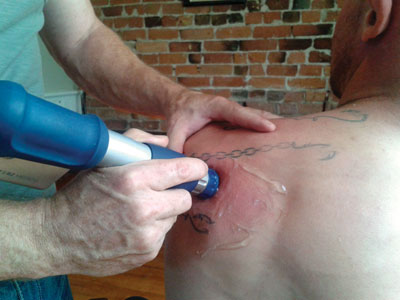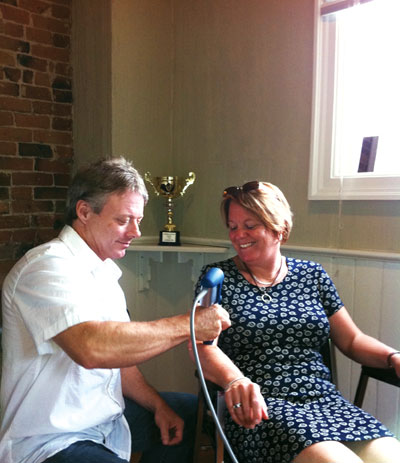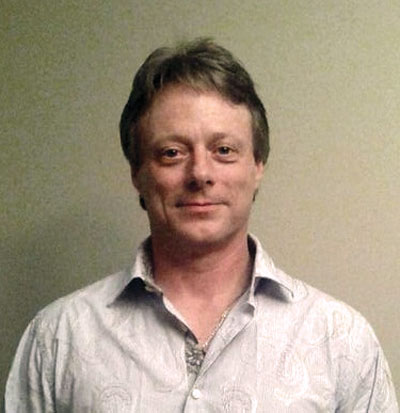
Features
Management
Operations
Radial Shockwave Therapy
You’re going to have fun with this!” exclaimed Dr. Robert Gordon as he patted me on the back and sent me on my way.
September 27, 2012 By Scott Grisewood RMT
You’re going to have fun with this!” exclaimed Dr. Robert Gordon as he patted me on the back and sent me on my way. North America’s leading medical expert on radial shockwave therapy had just spent, oh, about three minutes eradicating my recalcitrant rotator cuff pain and proving to me that I needed to get one of these machines too!
 |
|
| Following the application of a simple gel, radial shockwave therapy can be safely performed on a variety of patients.
|
Almost five years and 18 million shocks later, he didn’t have to tell me twice to experiment with shockwave on soft-tissue conditions other than the traditional tendonitis and calcific cases for which the benefits of this therapy are well known. From a career advancement and practice-building standpoint, the day I visited Dr. Gordon was “the day” everything changed!
The Science
Radial shockwave therapy (RST) is the use of short, intense energy waves travelling faster than the speed of sound. These energy waves stimulate the breakdown of scar tissue and fibroblasts. This process increases blood circulation and initiates metabolic activity, causing an inflammatory response that promotes and stimulates healing.
Over the past several years numerous articles and abstracts have been published regarding the effectiveness of RST.
Shockwave is clinically proven to have success rates of 91 per cent for calcific tendonitis, 90 per cent for plantar fasciitis and 77 per cent for tennis elbow. These studies show that, unlike laser and ultrasound, RST is a proven tissue regenerator.
Other Uses
Beyond its traditional applications, I have learned that RST is very effective at releasing restricted peripheral joints, thereby increasing the effectiveness of my treatments, as an RMT, significantly.
 |
|
| Treatment with the therapy is fast and does not cause discomfort for the patient.
|
Most importantly for me, this technology has extended the life of my practice by years, by taking the vast majority of “deep” work off my hands. It’s like having a 300-pound strongman/therapist at your side to do all your tough work. How do you put a price on that?
With portable machines now available, shockwave can also now be used onsite at sporting events and has helped increase the performance of many of my athletes.
Application
Traditional protocol dictates giving patients three treatments one week apart. Each treatment consists of 2,000 shocks in an area the size of a loonie.
The learning curve begins when you step away from “traditional” treatments and witness other applications for which RST is beneficial. For example, we can also use this technology to release joints. In this application, since we are not aiming at regeneration, the number and intensity of shocks necessary to see results can be decreased significantly. The same would apply in treating an arthroscopic knee surgery, post-operatively: with a moderate intensity of RST, acceleration of the healing process is noted along with a decrease in post-surgical pain.
Conditions Treated
Apart from tendonitis and calcific conditions, I have also had success in treating osteoarthritis pain and immobility, I.T. Band syndrome, scars, muscle cramps/spasms, trigger finger, flexion contractures due to cerebral palsy, and even frostbite.
In my experience, shockwave takes about a third of the recovery time out of rehabilitating a frozen shoulder.
Contraindications
RST is a no-go in pregnancy, and for open wounds, infections, cancer, open growth plates, anti-inflammatory medications and treatment over the spine or anterior ribcage.
Clinical Observations
Almost always there is a significant decrease in pain immediately after the first treatment. This is usually followed by discomfort the next day for approximately 24 hours. A number of pain-free days usually follow, with pain returning just before the second treatment. After the second treatment, there is, in most cases, no post-treatment pain the next day and any remaining pain continues to steadily diminish. Like I said, though, this is in “most cases.” Rarely do I observe any bruising but this is a possibility the clinician must keep in mind.
Deterrents to recovery include unaddressed biomechanical flaws, systemic disorders such as diabetes and low protein intake. Also included would be return to activity too soon. You would not believe the number of people who thought they felt good enough to try an activity out after the first treatment because they felt so good, but doing so can result in a significant setback.
Marketing
For me personally, the single most effective way I built my practice was by making lunch appointments with local orthopedic surgeons, MDs, chiropractors, physiotherapists, massage therapists and personal trainers.
The offer of a free lunch and treatment has proven to be very effective (and low-cost) in terms of advertising and building trusted referral partners.
In Summary
Normally, when someone says to me “it’s a no brainer” about some new technique or trend, I get a little suspicious – but Doc Gordon was right. Incorporating radial shockwave therapy has significantly changed my practice in a number of ways. Yes, I can tell you shockwave has increased my bottom line, extended the life of my practice and so on. However, what I get a kick out of most is coming to work every day and seeing the relief in people’s eyes while exploring the treatment possibilities of this amazing technology.
Benefits of RST to Patients
Benefits of RST to Practitioners
|
 |
|
If you have any questions regarding radial shockwave therapy, please feel free to contact me at info@goathleteschoice.com.
Scott Grisewood is owner/operator of Athletes Choice in Barrie, Ontario. In practice for the past 18 years, Scott continues to treat and train numerous world-class athletes in Canada and internationally.
Print this page